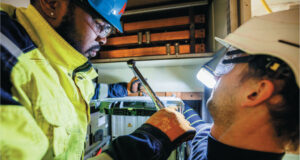
Is your maintenance organization reactive? Is work left unplanned and unscheduled? You’re not alone. Years ago, I was in a meeting at a North American chemical company discussing one of their production lines. The operations manager stated his expectations clearly. He said to maintenance: “Just set up your toolboxes at the line and I will let you know when to fix stuff.” The line uptime was running at 73 percent, but the target was 90 percent.
How do we make reliability and maintenance a strategy instead of a tactical reaction to what is happening?
PUMP PATROL
This chemical company had hired me as a maintenance engineer. The second week in my new job, the plant was down due to an equipment breakdown. At that time, we were a small producer with a small organization. That later changed as we expanded and grew into a strategic operation.
I walked out into the plant and discovered that a pump needed to be replaced to continue operation. As I approached the pump, no one was there or in the maintenance shop. At the same time, the operators were sitting in the control room taking a break.
Walking back to the pump I saw the millwright, Curtis, running by. I stopped him and asked, “When are you going to change the pump?” With stress in his voice, he answered, “I’m looking for Tim. He’s got the wrench.”
The next day I walked into the plant manager’s office and said, “We need to buy the maintenance guys some tools.” The plant manager looked at me (probably surprised by my visit to his office) and answered dubiously, “Do you really think we should buy them tools? They’re just going to take them home.”
I was momentarily caught off guard by his distrust. He kept looking at me. I continued, “Well, we should give them a toolbox each, with a standard set of tools. We need to trust these guys. I will have a list of the tools and check that they keep them in the box. If they lose them without an explanation, they will have to replace the missing tool.” That afternoon, we ordered toolboxes for each of the craftspeople.
A few months later, I noticed that one mechanic spent most of his time working to maintain the three vacuum pumps in place for primary filtration. As soon as one was rebuilt, the next one needed to be replaced. I thought, “This is a lot of wasted time for maintenance.” I reviewed the repairs and all the changes made to the pump design. It was obvious that many changes were made to save a buck or two. After doing a thorough review of the pump and the maintenance procedures, we completed a formal root cause failure analysis.
We found 19 major issues with the vacuum pumps. Most of them were due to our own workings. Some of these issues:
- Too much bending of the shaft due to changing the material of the shaft.
- Too much overhang on the belt drive, causing too much force.
- Using a carbon steel (instead of stainless steel) pump housing, causing corrosion.
- Wrong shaft tolerance for the bearings.
- Wrong procedure when mounting tapered bearings; lack of clearance.
- Not enough cooling capacity.
- Nitric and caustic overflowing from the process side to the vacuum pumps, causing additional corrosion.
- Imbalanced rotating assembly.
- Misalignment of pump housing sections during assembly.
You get the point. This was actually positive news—we prolonged the life from three months to around three years.
Later that year, I noticed that many of our bearing problems were caused by lubrication issues. At that point, we did not consider lubrication to be important; we did not have documented lubrication routes or work orders or standards in place for lubrication, and no training had been provided. The person assigned to do lubrication was untrained and jon restricted duty, so he couldn’t even access all the lube points.
To remedy this, we documented all the lubrication points, implemented improved handling and dispensing to keep them clean, and trained a selected (and unrestricted) team to do lubrication.
At that time, I decided to sit down with the maintenance manager and show him my view of how we could manage maintenance and reliability processes. I had learned this during my time as a young consultant working for IDCON. He said, “This is great!” and asked me if I could pitch this approach to the operations managers and staff.
My pitch was a success. The VP of operations declared that, from now on, we would include maintenance and reliability processes when we developed the annual area plans for the site.
After our pitch to operations, we all had a clear understanding that operations and maintenance must work together. We started to train operators how to do essential care and basic inspections on the equipment as a first line of maintenance.
Based on the pitch, the annual area plan now focused on the objective of maintenance and reliability. We would work with Technical Operations to develop yearly goals and actions to improve the heavy hitters in the maintenance process:
- Leadership and organizational development
- Work management, planning, and scheduling
- Preventive maintenance, essential care, and condition monitoring
- Materials management and spare parts
- Skills development
DECIDING TO BE THE BEST
We were a European company, and our overseas plants still performed much better than us. We were considered a “low-performing operation” and had the numbers to prove it. One day we decided that we would become the best performing operations in the entire company! What did we have to lose? We knew many of our plant sites were light years ahead of us in terms of experience and knowledge of the equipment. So, what could we do? We needed to learn how those other plants were doing maintenance.
I talked to the management team, and I was given a budget to visit the plants in Europe. When I arrived, I met with the maintenance staff. I looked at every piece of equipment I could find, taking pictures and noting how they were maintained and designed. I crawled into large tanks trying to find out how they were designed, and how the agitator was aligned. After I got back, we went through all my observations with the maintenance staff. Then, we came up with a list of tasks that would last us a year.
Based on the success of my visit, we started to share information about reliability and maintenance practices between the sites. This process quickly became an established tactical objective in our annual area plan development.
COMMUNICATION
Improving the maintenance process involves a lot of communication from everyone involved. You need to work through the hurdles when something goes awry.
I remember one New Year’s Eve I got a phone call from the shift mechanic. He said, “I have a work order here to change the oil in this raw material pump outside…” then he was silent. I realized it was 30° outside and that we had obviously made a scheduling mistake. I thanked him for calling me and said that it was a mistake to schedule this preventive maintenance (PM). It was a holiday, so we were operating on a skeleton crew. It was too cold to change oil at that temperature. “We will reschedule,” I told him.
This happened right after we had documented all the PMs in the plant, and we had just started to schedule them for the day crew and the shift crew. With the confidence he gained through making that phone call, that shift mechanic grew into a leader working hard to promote improvements in the reliability and maintenance process.
So far, we had been successful in improving plant productivity and deliveries through equipment reliability, but we were still having a difficult time recruiting skilled craftspeople. The location we were in had mostly labs, universities, facilities, agricultural, and pharma. We could not find any craftspeople who had experience with large processing equipment containing US$150,000 mechanical seals, 2,000 HP compressors, 4,160 volt electrical equipment, large gearboxes, large agitators, etc.
We set up a group to investigate and propose a training program for the maintenance department to develop new maintenance team members. The group delivered its findings, and the conclusion was that we needed better understanding of equipment theory, troubleshooting skills and time to practice on the job.
Based on the recommendations, we implemented a training program that included basic theory; developed testing requirements; and found the time and steps it would take to get on-the-job training and coaching about how to troubleshoot and do rebuilds. This became an important part of developing our maintenance team and attracting people to the maintenance function.
A huge sign of success: I noticed that many of our staff and craftspeople started visiting my office almost daily to share thoughts on how to improve. I took this engagement and initiative as a sign that our whole department was trying to improve our processes and figure out how to work smarter every day. I would even say that everybody was driving reliability and maintenance—not just a few of us. Employees were noticing that the changes we made started to make a big difference, and they were getting on board fast.
I have worked in approximately 50 paper mills around the world. The different stories from my experience in a chemical plant tell me that maintenance and reliability must be a strategic objective for every industry, including pulp and paper mills.
The question is, should you make reliability and maintenance a strategic objective from the start? Or should you need to prove that it works with success stories before you are allowed to make it a strategic objective? If you have an opinion and want to discuss further, email me at [email protected].
 Paper 360
Paper 360
